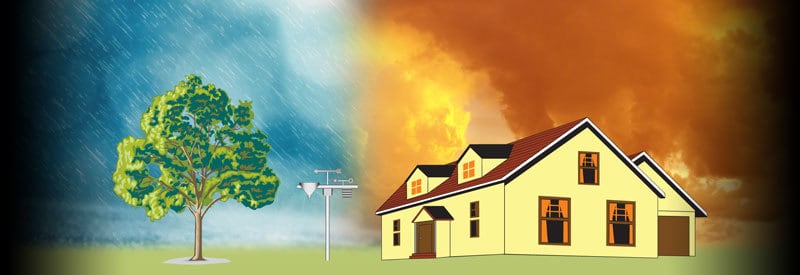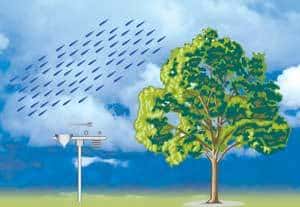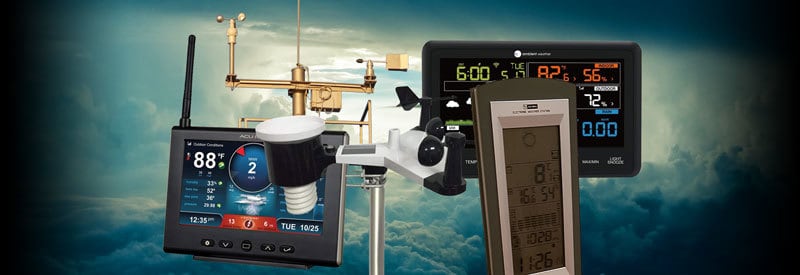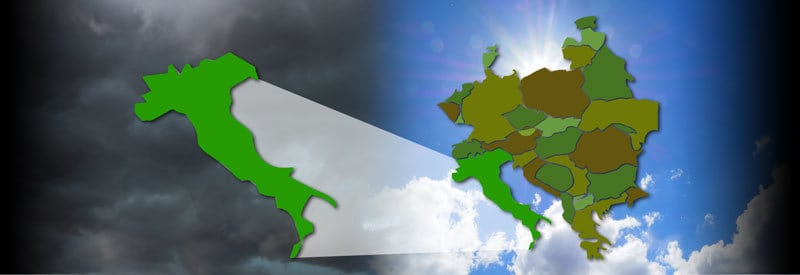Most of us have been very frustrated with inaccurate weather forecasts on more than one occasion. Many of these "inaccuracies" can be attributed to the difference between local & regional weather.
Local weather primarily refers to the prevailing atmospheric conditions in a relatively small localized area at a specific period in time, like a small town or suburb. In contrast, regional weather refers to the atmospheric conditions present in a broader geographical region like a county or state.
The weather forecast predicts "sunny conditions, with a light south-easterly breeze with high of 75 degrees Fahrenheit." Great! You dress accordingly, light and comfortable, and head off to work 12 miles away...
As you jump out of your car in the drizzling rain and run for your office to try and make it before getting completely soaked, you mumble a few "choice words" towards the weather forecaster whose advice you took the previous night while a shiver runs through you from the surprisingly chilly gust of wind also hitting you. What light breeze and sunny conditions!?
Sounds familiar? You just experience one aspect of the difference between local and regional weather. What may sound just as familiar is talking to your spouse/partner later the day, who just happens to work 15 miles away from home, but at the opposite side of town.
As you complain and describe your miserable morning, spending more than an hour getting dry and still cold, you are more than a little surprised to hear that he/she is having lunch with a few work colleagues outside at their local coffee shop, since its "such a nice day"...
This scenario takes place across the world every single day and in many cities and rural towns, so please don't feel alone. The weather gods and forecasters are not out to get you, I promise. The question, though, is, was the weather forecast wrong? Probably not, and I will explain why in a moment.
Let's just get a few technicalities out of the way that will help you better understand everything as I continue helping you make sense of this everyday occurrence. Let's start with the term "weather" and what it is:
Weather can be summed up as a description of atmospheric conditions in a certain area over a fairly short period of time. This includes variables like humidity, temperature, atmospheric pressure, and air movement (wind.) Local weather is the atmospheric conditions in your immediate vicinity, while regional weather covers a much larger region like a county or state.
In other words, it simply tells you how hot or cold, rainy or sunny, and windy it is or going to be in a certain area over a short period of time. This is something we all know and considered common sense. Having said that, the weather is a lot more complex and volatile, and especially difficult to forecast over a small, localized area.
(As the scenario described at the start of this article clearly showed and we all experienced .)
The Difference Between Local And Regional Weather
Local weather primarily refers to the prevailing atmospheric conditions in your immediate vicinity at a specific period in time, like a small town or suburb. In contrast, regional weather refers to the atmospheric conditions present in a broader geographical area like a county or state.
Now we can have a closer look at the difference between local and regional weather.
Regional Weather
Regional weather is normally focused on a specific region within a country. For example, looking at the weather of Northern California is a good example of regional weather.
Although much more targeted than the overall weather condition of any country, it still covers a fairly broad area, sometimes spanning a few hundred miles.
(And it's within this broad area that so many local variations in the weather can occur. More on that shortly.)
Meteorologists (weather forecasters) make use of a huge amount of data gathered from numerous sensors on the ground, in the air, and from space.
Various different data (temperature, humidity, air pressure, etc.) is collected from a network of weather stations spread out throughout the region. This is combined with satellite images showing weather systems hours or even days away. Data is even collected from devices such as weather balloons send up to collect very specific data in the lower and upper atmosphere.
All this data, combined with looking at a logged history of weather patterns and tendencies over the years, allow meteorologists to make very accurate regional forecasts. (Using satellite images that show weather systems still days away allows meteorologists to even provide us with the 3-5 day weather forecasts we often see during forecasts. This is not as accurate a 24-hour forecast, though, due to the continuously changing nature of weather systems.)
And please take note, we are referring to regional, NOT local weather here.
Local Weather
Local weather is normally focused on a "small location" like a city or town and surrounding areas. For example, Los Angeles and its immediate surroundings are one example of a "small location."
Local meteorologists make use of the same data that their regional colleagues use. Additionally though, they also make use of sensors located in the immediate vicinity, normally from weather stations located at places like the local airport. Using a combination of regional and locally obtained data, they are able to make a much more accurate forecast for your specific area.
This can be very helpful, as within a big weather system, like a cold front spanning more than a hundred miles and moving very slowly, there may be pockets of warm and sunny conditions that can influence a smaller area within the bigger system. This can cause a specific city or town to experience sunny conditions, while the bigger surrounding region is experiencing the expected cold and wet conditions of the cold front.
(You should now be able to better understand why scenarios like the one described in this article introduction occur.)
The term "local weather" has started to become a bit vaguer lately, as some local forecasters are trying to be even more specific, realizing that weather conditions can vary substantially, even in a fairly localized area.
As a result, some local radio stations and Weather Apps can focus on specific areas within a city or town. In Los Angeles, for example, some "experts" can focus on the weather in Northridge or South Los Angeles.
They may make use of personal/home weather stations (or network of weather stations) situated in their area and combine that with the official local forecast to make a more specific forecast of their own.
Modern personal/home weather stations have become much more accurate during recent years, enabling users to make fairly accurate 12-24 hour forecasts. (If installed and interpreted correctly, which is often not the case.)
As you can see for yourself by now, local weather forecasts can be a mixed blessing.
What Does This Mean For You?
Now that you have a clear idea of what exactly the difference between local and regional weather is, you may still be wondering how this influences you more directly.
Let me first point out that not all weather forecasts are created equally. Whether you use a weather app on your smartphone, read the forecast on your laptop, or get your forecast from a radio or television broadcast - make sure you vet and test each one over time to test its accuracy and reliability.
Naturally, if your daily movements are in and around your city or town, paying attention to your local weather forecast is important. Similarly, if you tend to travel within a broader region on a daily or weekly basis, keeping an eye on the regional weather should be a priority for you.
Useful Tip: Getting a local and regional weather forecast from different credible sources is always a very good idea to get the best possible picture of what to expect, especially if weather conditions are important to you.
Now, you can get even more specific, especially for the weather enthusiasts among you. (Or if you are a bit of a weather nerd like yours truly.) As personal/home weather systems are much more accurate and affordable than in the past, many users opt to install their own systems to monitor the weather in their immediate vicinity.
Combined with the data you get from general local forecasts, you are able to get a much better indication of weather conditions over the next 24 hours at your location. This may seem like a bit of overkill for you but can turn out to be a valuable investment and an interesting hobby.
This is especially useful for people living in remote areas, farms, nurseries, and other places where up-to-date weather information at their specific location is of the utmost importance.
(I will cover home weather systems and their uses in detail on this site, so make sure you check back regularly to see what is new. You may just realize how interesting the weather actually is and may just get hooked!)
Conclusion
An there you have the two different types of weather explained in more detail to help you better understand how each one influence you.
In summary, regional weather covers a large area with many fluctuations within it but tends to be very accurate. Local weather targets a more specific location which can benefit anyone who needs more information about their immediate vicinity but can be more unreliable due to sudden small weather changes within the larger system (as well as slightly less comprehensive and accurate measuring equipment.)
So next the weather forecaster gets it wrong and you are soaked in rain, rather then basking in sunshine, don't be too hard on him/her. It's not always as easy as it looks!
Never miss out again when another interesting and helpful article is released and stay updated, while also receiving helpful tips & information by simply clicking on this link .
Until next time, keep your eye on the weather!

















